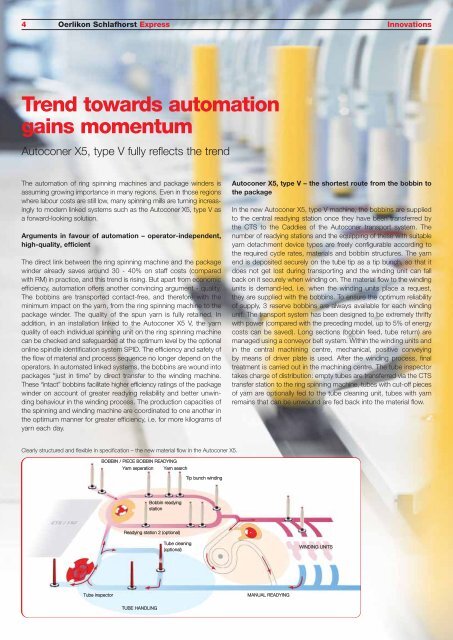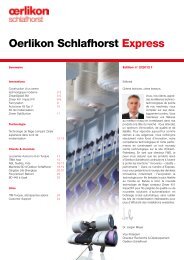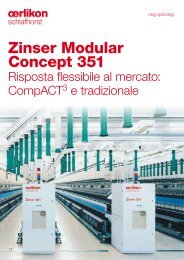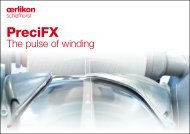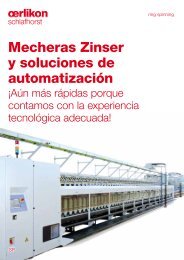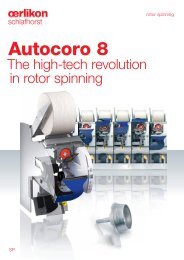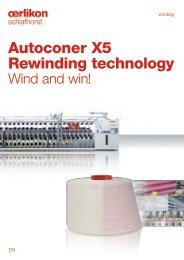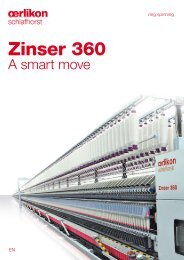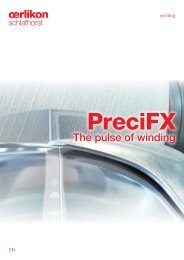Oerlikon Schlafhorst Express - Oerlikon Schlafhorst - Oerlikon Textile
Oerlikon Schlafhorst Express - Oerlikon Schlafhorst - Oerlikon Textile
Oerlikon Schlafhorst Express - Oerlikon Schlafhorst - Oerlikon Textile
You also want an ePaper? Increase the reach of your titles
YUMPU automatically turns print PDFs into web optimized ePapers that Google loves.
4<br />
<strong>Oerlikon</strong> <strong>Schlafhorst</strong> <strong>Express</strong><br />
Trend towards automation<br />
gains momentum<br />
Autoconer X5, type V fully reflects the trend<br />
The automation of ring spinning machines and package winders is<br />
assuming growing importance in many regions. Even in those regions<br />
where labour costs are still low, many spinning mills are turning increasingly<br />
to modern linked systems such as the Autoconer X5, type V as<br />
a forward-looking solution.<br />
Arguments in favour of automation – operator-independent,<br />
high-quality, efficient<br />
The direct link between the ring spinning machine and the package<br />
winder already saves around 30 - 40% on staff costs (compared<br />
with RM) in practice, and this trend is rising. But apart from economic<br />
efficiency, automation offers another convincing argument - quality.<br />
The bobbins are transported contact-free, and therefore with the<br />
minimum impact on the yarn, from the ring spinning machine to the<br />
package winder. The quality of the spun yarn is fully retained. In<br />
addition, in an installation linked to the Autoconer X5 V, the yarn<br />
quality of each individual spinning unit on the ring spinning machine<br />
can be checked and safeguarded at the optimum level by the optional<br />
online spindle identification system SPID. The efficiency and safety of<br />
the flow of material and process sequence no longer depend on the<br />
operators. In automated linked systems, the bobbins are wound into<br />
packages “just in time” by direct transfer to the winding machine.<br />
These “intact” bobbins facilitate higher efficiency ratings of the package<br />
winder on account of greater readying reliability and better unwinding<br />
behaviour in the winding process. The production capacities of<br />
the spinning and winding machine are coordinated to one another in<br />
the optimum manner for greater efficiency, i.e. for more kilograms of<br />
yarn each day.<br />
Clearly structured and flexible in specification – the new material flow in the Autoconer X5.<br />
Tube inspector<br />
BOBBIN / PIECE BOBBIN READYING<br />
Yarn seperation<br />
TUBE HANDLING<br />
Yarn search<br />
Bobbin readying<br />
station<br />
Readying station 2 (optional)<br />
Tube cleaning<br />
(optional)<br />
Tip bunch winding<br />
MANUAL READYING<br />
WINDING UNITS<br />
Innovations<br />
Autoconer X5, type V – the shortest route from the bobbin to<br />
the package<br />
In the new Autoconer X5, type V machine, the bobbins are supplied<br />
to the central readying station once they have been transferred by<br />
the CTS to the Caddies of the Autoconer transport system. The<br />
number of readying stations and the equipping of these with suitable<br />
yarn detachment device types are freely configurable according to<br />
the required cycle rates, materials and bobbin structures. The yarn<br />
end is deposited securely on the tube tip as a tip bunch, so that it<br />
does not get lost during transporting and the winding unit can fall<br />
back on it securely when winding on. The material flow to the winding<br />
units is demand-led, i.e. when the winding units place a request,<br />
they are supplied with the bobbins. To ensure the optimum reliability<br />
of supply, 3 reserve bobbins are always available for each winding<br />
unit. The transport system has been designed to be extremely thrifty<br />
with power (compared with the preceding model, up to 5% of energy<br />
costs can be saved). Long sections (bobbin feed, tube return) are<br />
managed using a conveyor belt system. Within the winding units and<br />
in the central machining centre, mechanical, positive conveying<br />
by means of driver plate is used. After the winding process, final<br />
treatment is carried out in the machining centre. The tube inspector<br />
takes charge of distribution: empty tubes are transferred via the CTS<br />
transfer station to the ring spinning machine, tubes with cut-off pieces<br />
of yarn are optionally fed to the tube cleaning unit, tubes with yarn<br />
remains that can be unwound are fed back into the material flow.


